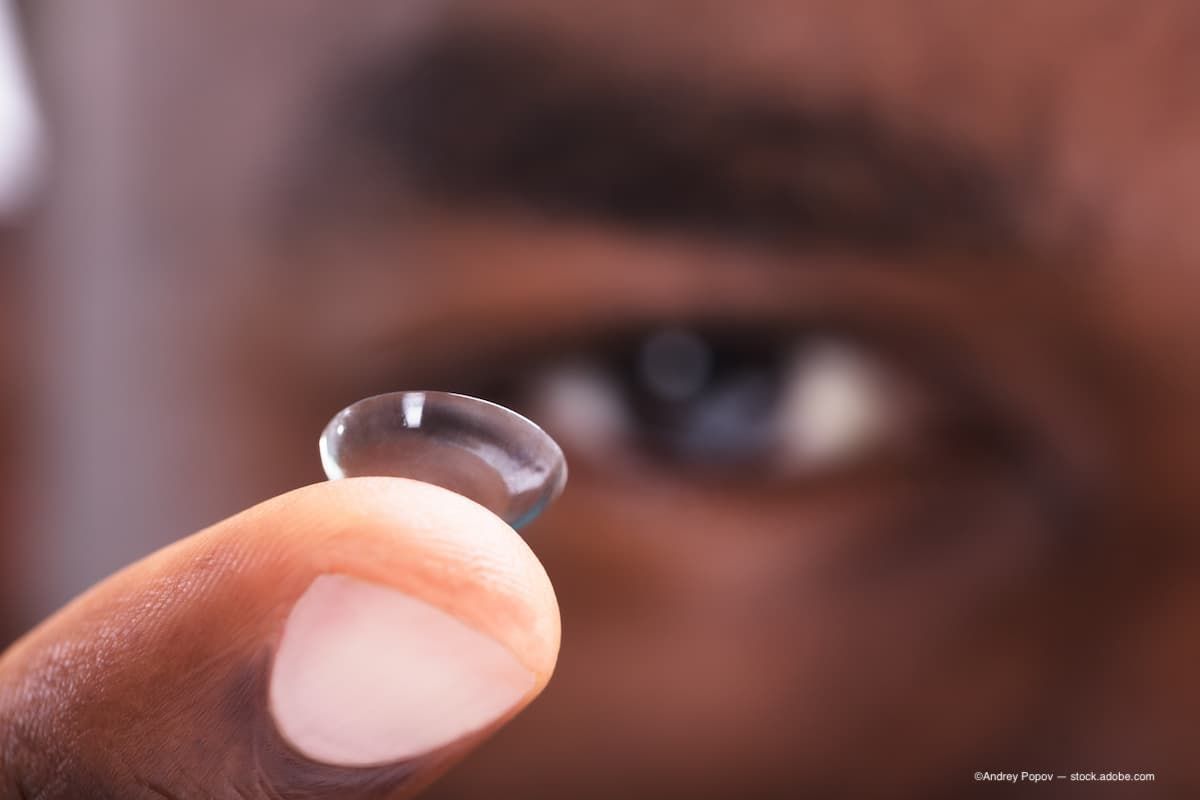- COVID-19
- Biosimilars
- Cataract Therapeutics
- DME
- Gene Therapy
- Workplace
- Ptosis
- Optic Relief
- Imaging
- Geographic Atrophy
- AMD
- Presbyopia
- Ocular Surface Disease
- Practice Management
- Pediatrics
- Surgery
- Therapeutics
- Optometry
- Retina
- Cataract
- Pharmacy
- IOL
- Dry Eye
- Understanding Antibiotic Resistance
- Refractive
- Cornea
- Glaucoma
- OCT
- Ocular Allergy
- Clinical Diagnosis
- Technology
Study: Contact lenses to diagnose glaucoma
The new contact lenses contain micro-sensors which monitor changes in IOP over a period of several hours, sending the data collected wirelessly so it can be analyzed by an ophthalmologist and a diagnosis given.
(Image Credit: AdobeStock/Andrey Popov)

A team of researchers at Northumbria University is developing contact lenses that can help diagnose glaucoma.
The diseases impacts about 70 million people around the world. However, around half of those living with the disease don’t even know it. The disease develops slowly over time and ophthalmologists and other eye care professionals may only make a diagnosis during routine eye tests, by which time lasting damage may already have been caused.
According to a study published in Contact Lens and Anterior Eye,1 this could change in future as researchers from the UK and Turkey have developed a contact lens which can detect changes in eye pressure which signal possible glaucoma.1
The researchers pointed out the contact lenses contain micro-sensors which monitor changes in IOP over a period of several hours, and send the data collected wirelessly to be analyzed by an ophthalmologist and a diagnosis is then given.2
The research has been conducted by Hamdi Torun, PhD, of Northumbria University in Newcastle upon Tyne, England; and Professors Günhan Dündar, PhD, and Arda D. Yalcinkaya, PhD, both of Boğaziçi University, in Istanbul, Turkey.
The researchers’ paper is titled A first-in-human pilot study of a novel electrically-passive metamaterial-inspired resonator-based ocular sensor embedded contact lens monitoring intraocular pressure fluctuations. It lays out the findings from their initial pilot study of 6 participants.1
After determining the technology works successfully, the researchers expect to continue with additional research that will include a larger group of participants, expected to take place over the next year. The lenses will be marketed and sold through GlakoLens, a spin-off company.
A key benefit of utilizing the GlakoLens contact lenses to diagnose glaucoma in lieu of a traditional examination is that measurements can easily be completed over a longer period of time, giving a more accurate diagnosis.2
“Intra-ocular pressure (IOP) can vary greatly over a 24-hour period, so it is important to monitor the patient either at intervals or ideally continuously for a whole day to get the best insight into the health of their eyes,” Torun said in the news release.
Hamdi Torun, PhD, is pictured with the contact lens. (Image credit: Simon Veit-Wilson/Northumbria University)

Torun explained that traditional methods for measuring IOP involve initially going to a clinic for a single measurement in a day, the result of which can be misleading due to the natural variation of IOP.1
“If a variation is detected, further investigation is then needed which requires hospitalization for a whole day, during which repeated measurements are taken using a technique called Goldmann applanation tonometry, which involves numbing the eye with drops and then using a small cone to touch the cornea to measure the pressure,” he explained in the news release.“However, studies have shown that waking patients up at night to carry out measurements can make the results less accurate, in addition to obvious discomfort to the patients and the economic cost to the healthcare system.”
Torun also explained how the contact lenses work.
“The benefit of the contact lenses we have developed is that once placed in the eye, the patient can then go about their day as normal while their IOP measurements are recorded and sent to a doctor for analysis once the 24-hour period of testing is complete,” he said in the release.
The new system has been tested with 6 healthy volunteers, during which time they were asked to drink 1.5 liters of water and lie flat to intentionally increase their IOP levels.2
According to the news release, the lenses aren’t the first developed to measure IOP, previous products have used an electrically active silicon chip, which results in a thicker, less comfortable lens. The chip also makes the lens less flexible and can restrict vision, making it more difficult to carry out daily activities.
The researchers noted in the study that the contact lenses by GlakoLens use an electrically passive sensor embedded in a disposable soft contact lens, and a wearable electronic readout system to collect, store and process the data – making the lens more comfortable and allowing the patient to go about their day as normal.1
In addition to diagnosing glaucoma, it is possible that the lenses could be used to detect other health conditions by measuring glucose, lactic acid and other molecules present in eye.
“We believe this technology has huge potential and could not only save the sight of patients in the early stages of glaucoma but also provide early diagnosis of other diseases in future,” Torun concluded in the news release.
